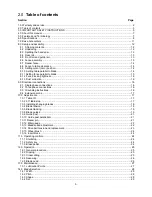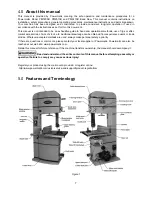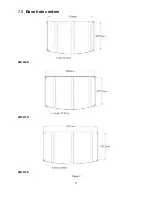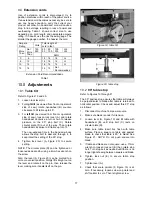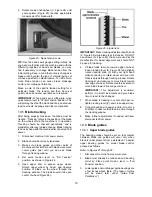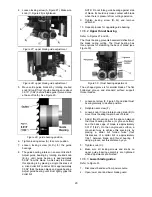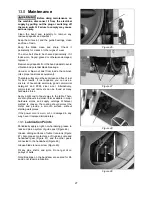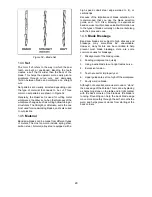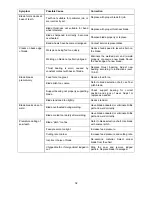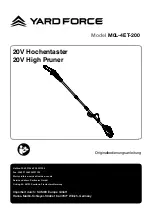
17
9.4
Extension cords
Use of extension cords is discouraged; try to
position machines within reach of the power source.
If an extension cord becomes necessary, be sure to
use one heavy enough to carry the current your
product will draw. An undersized cord will cause a
drop in line voltage resulting in loss of power and
overheating. Table 1 shows correct size to use
depending on cord length and nameplate ampere
rating. If in doubt, use the next heavier gauge. The
smaller the gauge number, the heavier the cord.
Ampere
Rating
Volts
Total length of
cord in feet
More
Than
Not
More
Than
120
240
25
50
50
100
100
200
150
300
AWG
0
0
0
6 18
16 16
14
0
6 10 18
16 14
12
10 12 16
16 14
12
12 16 14
12
Not
Recommended
Extension Cord Recommendations
Table 1
10.0
Adjustments
10.1
Table tilt
Refer to Figures 19 and 20.
1. Loosen lock lever (A).
2. For
right tilt
(as viewed from front or operator’s
side of saw), rotate handwheel (B) counter-
clockwise to tilt table up to 45°.
3. For
left tilt
(as viewed from front or operator’s
side of saw), loosen lock lever (A) and rotate
handwheel clockwise a turn or two to release
pressure on the 90° stop bolt (C). Rotate
circular plate (D) out of the way. Then rotate
handwheel clockwise to tilt table up to to 15°.
The now-exposed hole in the band saw body
allows the stop bolt to descend through it, to
keep intact the setting of the 90° stop.
4. Tighten lock lever (A, Figure 20) to secure
setting.
NOTE: The circular plate (D) can be tightened or
loosened as desired by using a 4mm hex wrench on
the screw.
Also, the lever (A, Figure 20) can be pivoted to a
more convenient position. Simply lift straight out on
the lever and rotate it on the pin, then release the
lever making sure it seats itself on the pin.
Figure 19: table tilt
Figure 20: table stop
10.2
90° table stop
Refer to Figures 19 through 21.
The 90° positive stop ensures that table will always
be perpendicular to blade after table is returned to
horizontal position. Check and adjust this 90° stop
as follows:
1. Disconnect machine from power source.
2. Make sure blade is under full tension.
3. Loosen lever (A, Figure 19) and tilt table with
handwheel (B), until stop bolt (C) rests on
circular plate (D).
4. Make sure table insert lies flush with table
surface. Place a square on table and against
blade to check that table is 90° to blade. See
Figure 21.
NOTE: Do not push square into
blade.
5. If table and blade are not square, use a 17mm
wrench to loosen lock nut (E) then rotate stop
bolt. Turn stop bolt as needed until there is no
longer light showing between square and blade.
6. Tighten lock nut (E) to secure table stop
position.
7. Tighten
lever
(A).
8. Check that scale pointer (F, Figure 19) is at
zero. If necessary, loosen screw on pointer and
shift pointer to zero. Then retighten screw.
Summary of Contents for 1791257B
Page 11: ...11 7 0 Base hole centers PM1800B PM2013B PM2415B Figure 2...
Page 35: ...35 17 1 1 Complete Machine with Accessories PM 1800B 2013B Exploded View I...
Page 36: ...36 17 1 2 Complete Machine with Accessories PM 1800B 2013B Exploded View II...
Page 37: ...37 17 1 3 Complete Machine with Accessories PM2415B Exploded View I...
Page 38: ...38 17 1 4 Complete Machine with Accessories PM2415B Exploded View II...
Page 58: ...58 This page intentionally left blank...
Page 59: ...59 This page intentionally left blank...
Page 60: ...60 427 New Sanford Road LaVergne Tennessee 37086 Phone 800 274 6848 www powermatic com...

